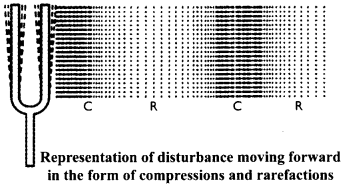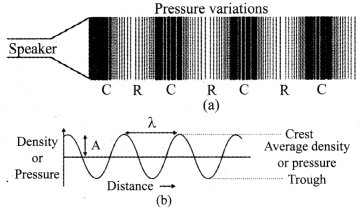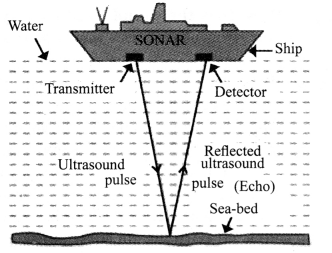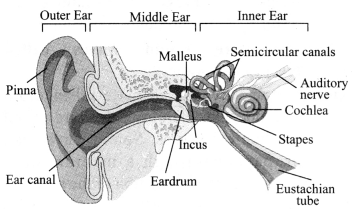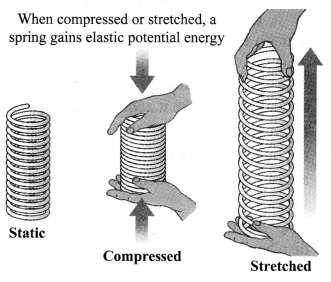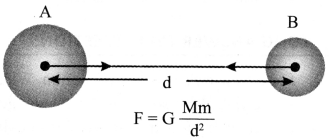JAC Board Class 9th Science Solutions Chapter 14 Natural Resources
JAC Class 9th Science Natural Resources InText Questions and Answers
Page 193
Question 1.
How is our atmosphere different from the atmospheres on Venus and Mars?
Answer:
Our atmosphere contains gases like nitrogen, oxygen, carbon dioxide, water vapour and other gases in very small amounts. Atmospheres of Venus and Mars have about 95% of carbon dioxide. So, life is not possible there.
Question 2.
How does the atmosphere act as a blanket?
Answer:
The atmosphere acts as a blanket by performing the following functions:
- It keeps the average temperature of the earth fairly constant during day time and even during the course of whole year. .
- It prevents a sudden increase in the temperature during day time.
- It slows down the escape of heat from the surface of the earth into outer space during night time.
Question 3.
What causes winds?
Answer:
An uneven heating of the earth’s surface causes winds. On being heated, air becomes lighter and rises up. As a result, a region of low pressure is created. Then, air from a high pressure region moves to the low pressure region, causing wind.

Question 4.
How are clouds formed?
Answer:
During daytime, on being heated, a large amount of water evaporates from various water bodies and goes into the air. A part of this water vapour also reaches the atmosphere through biological activities. This causes the air in the atmosphere to heat up. When this heated air rises, it expands and cools, which results in the condensation of water vapour forming water droplets. The presence of dust and other suspended particles in air also facilitates the process of condensation. The formation of water droplets leads to the formation of clouds.
Question 5.
List any three human activities that you think would lead to air pollution.
Answer:
Three human activities which lead to air pollution are:
(a) Burning of fuels like coal, petroleum, kerosene.
(b) Smoke released from industries.
(c) Emissions from vehicles.
Page 194
Question 1.
Why do organisms need water?
Answer:
Organisms need water for the following activities:
(a) All cellular processes occur inside water.
(b) Transportation of substances in our body takes place by dissolving in water.
(c) Terrestrial animals require water for getting rid of wastes from their body.
(d) Plants require water for photosynthesis.
Question 2.
What is the major source of fresh water in the city/town/village where you live?
Answer:
The major sources of water are:
(a) Water in the form of snow, ice – covered mountains
(b) Underground water in well
(c) Surface water like in lakes, rivers, ponds
(d) Rainfall
(e) Stored rainwater in tanks, dams
Question 3.
Do you know of any activity which may be polluting this water source?
Answer:
Yes, the water is polluted by sewage, dumping waste in river, factory waste, etc.
Page 196
Question 1.
How is soil formed?
Answer:
Soil is formed by breaking down of rocks at or near the surface of the earth through various physical, chemical and biological processes by various factors such as the sun, water, wind and living organisms.
1. Sun: During day time, the rocks get heated up. This causes the rocks to expand. During night time, these rocks cool down and contract. However, all parts of the rocks do not undergo expansion and contraction at the same rate. This causes the formation of cracks and breaking up of huge rocks into smaller pieces.
2. Water: Water catalyses the process of formation of soil in two ways:
- Water goes into the cracks and crevices formed in the rocks. When this water freezes, its volume increases. As a result, the size of the cracks also increases. This helps in the weathering of rocks.
- Running water wears away hard rocks over long periods of time. Water moving in fast speed carries big and small particles of rocks downstream. These rocks rub against each other, resulting in breaking down of rocks. These smaller particles are carried away by running water and deposited down its path.
3. Wind: Strong winds carry away rocks, which causes rubbing of rocks. This results in the breaking down of rocks into smaller and smaller particles.
4. Living organisms: Some living organisms like lichens help in the formation of soil. Lichens also grow on rocks. During their growth, lichens release certain substances, which cause the rock surface to powder down forming a thin layer of soil. On this thin layer of soil, some small plants like moss also grow. They further cause the breaking down of the rock particles with the growth of their roots.
Question 2.
What is soil erosion?
Answer:
The removal of fertile topsoil by air, wind or water is called soil erosion.
Question 3.
What are the methods of preventing or reducing soil erosion?
Answer:
The following are some methods which can prevent or reduce soil erosion:
- Soil should have some vegetation, like grass, growing on it, so that it does not get carried away by rainwater or wind.
- Afforestation or planting of trees, so that roots hold the soil and prevent soil erosion.
- Overgrazing should be avoided.
Page 201
Question 1.
What are the different states in which water is found during the water cycle?
Answer:
Various states in which water is found during the water cycle are:
- Water in liquid state: present in various sources like lakes, rivers, underground water, etc.
- Water vapour (gaseous state): Water evaporates from water bodies and due to transpiration by plants.
- Clouds: Condensed water vapour is present in clouds.
- Water as rain is in liquid state while that as snowfall is in solid state.
Question 2.
Name two biologically important compounds that contain both oxygen and nitrogen?
Answer:
Two biologically important compounds that contain both oxygen and nitrogen are:
- Amino acids
- Deoxyribonucleic acid (DNA)
Question 3.
List any three human activities which would lead to an increase in the carbon dioxide content of air.
Answer:
The following activities of human beings may increase carbon dioxide content of air:
(a) Burning of fuels in various processes like heating, cooking, transportation and industries.
(b) Human induced forest fires.
(c) The process of deforestation, i.e., the cutting down of trees. This decreases the uptake of carbon dioxide for photosynthesis. Eventually, the content of carbon dioxide increases.

Question 4.
What is the greenhouse effect?
Answer:
Some gases like carbon dioxide, methane and nitrous oxide prevent the escape of heat from the earth’s surface by trapping it. This increases the average temperature of the earth. This is called the greenhouse effect.
Question 5.
What are the two forms of oxygen found in the atmosphere?
Answer:
Oxygen is present in free form like O2 (oxygen molecule), ozone (O3) and combined form like oxides of metals and non-metals, e.g., CO2, NO2, SO2, H2O, etc.
JAC Class 9th Science Natural Resources Textbook Questions and Answers
Question 1.
Why is the atmosphere essential for life?
Answer:
Atmosphere is very important for sustaining life:
- It contains various gases like O2, CO2, N2 which are required for various life processes by plants and animals.
- CO2 gas is used by plants to prepare food by the process called photosynthesis
- Oxygen is required for burning, combustion and for respiration.
- Ozone layer is acting as a protective layer, which prevents the harmful U.V. rays to enter the earth’s atmosphere.
- C2 dissolved in water forms carbonates which are required by the animals to form shells.
Question 2.
Why is water essential for life?
Answer:
Water is essential for life because of the following reasons:
- All life processes that take place in the cells require water medium.
- Water is needed for transportation of various substances from one part of the body to the other in dissolved form.
- All reactions taking place within our body and within the cells occur between substances that are dissolved in water.
- Terrestrial life – forms require fresh water for the transportation of substances and also to get rid of high amounts of wastes.
Question 3.
How are living organisms dependent on the soil? Are organisms that live in water totally independent of soil as a resource?
Answer:
All living organisms are directly or indirectly dependent on soil. dissolved in water forms carbonates which are required by the animals to form shells.
Question 2.
Why is water essential for life?
Answer:
Water is essential for life because of the following reasons:
- All life processes that take place in the cells require water medium.
- Water is needed for transportation of various substances from one part of the body to the other in dissolved form.
- All reactions taking place within our body and within the cells occur between substances that are dissolved in water.
- Terrestrial life-forms require fresh water for the transportation of substances and also to get rid of high amounts of wastes.
Question 3.
How are living organisms dependent on the soil? Are organisms that live in water totally independent of soil as a resource?
Answer:
All living organisms are directly or indirectly dependent on soil. Plants obtain water and minerals from the soil and prepare food for themselves and animals. Other organisms that live in water are not totally independent on soil because the microbes growing on the soil in water are the primary producers in the soil which start the food chain and even other microbes that live in soil help in the decomposition of dead plants and animals in water to return the nutrients and elements back to the water.
Question 4.
You have seen weather reports on television and in newspapers. How do you think we are able to predict the weather?
Answer:
Prediction of weather can be done by studying wind patterns which decide rainfall patterns. It also shows areas of low pressure and high pressure. In large parts of India, rains are mostly. brought by the South – West or North – East monsoons.

Question 5.
We know that many human activities lead to increasing levels of pollution of the air, water-bodies and soil. Do you think that isolating these activities to specific and limited areas would help in reducing pollution?
Answer:
If the human activities which lead to increasing levels of air, water and soil pollution are spread in wider area, the pollutants will spread more, but if these are limited and confined to a place, the soil and water pollution can be controlled to some extent and air pollution can also be minimised.
Question 6.
Write a note on how forests influence the quality of air, soil and water resources.
Answer:
Forests influence the quality of air, soil and water resources in various ways. Some of them are as follows:
1. Forests balance the percentage of carbon dioxide and oxygen in the atmosphere. The increasing amount of carbon dioxide caused by human activities is balanced by a larger
intake of carbon dioxide by plants during the process of photosynthesis. Simultaneously, a large amount of oxygen is released.
2. Forests prevent soil erosion. Roots of plants bind the soil tightly in a way that the surface of the soil cannot be eroded away by wind, water, etc.
3. Forests help in the replenishment of water resources. During the process of transpiration, a huge amount of water vapour goes into the air and condenses to form clouds. These clouds cause rainfall that recharges water bodies. Also, roots of plants facilitate the seepage of rainwater into the ground and help to recharge the water table.

